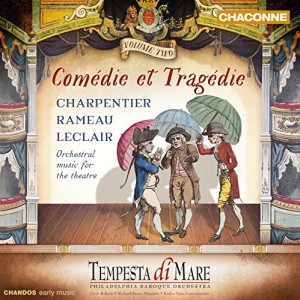Comédie et Tragédie, vol. 2 – Charpentier, Rameau, Leclair:
Orchestral music for the theatre
French baroque music sports two key ingredients: dance rhythms and the French language itself. When this music was new in the 1670’s and 1740’s, all this was common knowledge: no need to tell musicians how fast to play, say, a minuet, or how to lilt a line to mimic the short and long syllables in spoken word. Everybody knew that! A modern-day ensemble has to recreate this musical language and learn how to speak with a similar accent. But once you get it, this music is pure fun.
This release completes Tempesta di Mare’s Comédie et Tragédie project, and consists of orchestral suites from three dramatic works of the French stage, spanning seventy-three years, all highlighting the importance of dance as a part of drama.
The comédie-ballet was the brainchild of the French comedic actor, singer, dancer, and playwright Molière. After ten years of collaborating with Jean-Baptiste Lully, whose suite from Le Bourgeois Gentilhomme features in Comédie et Tragédie volume 1, he turned to Marc-Antoine Charpentier. The outcome was Le Malade imaginaire (the hypochondriac), the fourth performance of which would prove Molière’s last, as he died on stage.
Scylla et Glaucus, a tragédie en musique, is the only stage work by Jean-Marie Leclair, the foremost violinist of his generation and a composer whose late opera shows the clarity of his orchestration and places its focal point on the strings, as one would expect.
Jean-Philippe Rameau’s ballet-héroique, Les Fêtes de Polymnie, is contemporary with Leclair’s opera but more forward looking in its approach, and famous for the ingenuity of Rameau’s colourful orchestration, particularly obvious in the overture.*
This recording hits the shelves February 26, 2016, but you can get your copy from us today, or in the lobby at our March 5 and 6 performances of The Nations. The music is also available for download now from The Classical Shop.
* From the liner notes by Robert Green.
